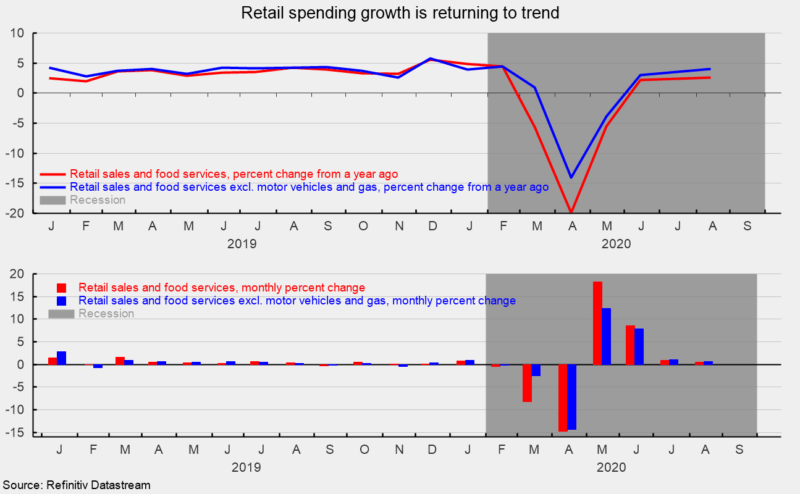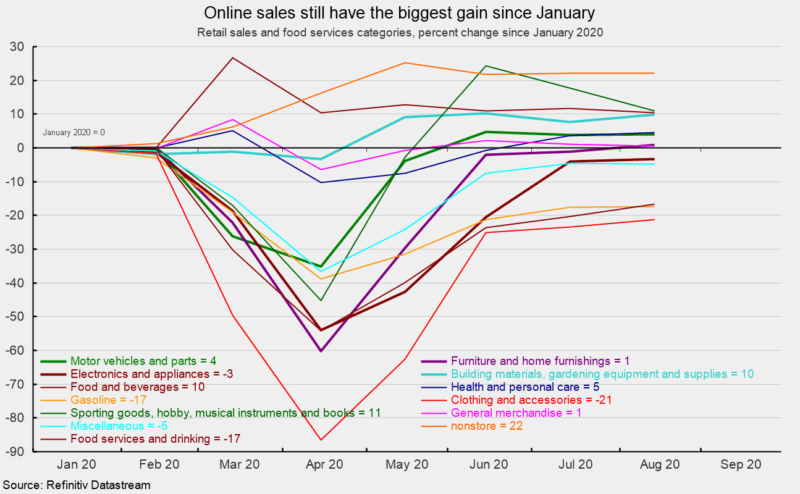Retail Spending Rises in August But the Pace Slows
Retail sales and food-services spending posted another gain in August, rising 0.6 percent from the prior month. However, the gain was below the 1.0 percent consensus expectation and follows a downwardly revised 0.9 percent gain in July (from an initial estimate of a 1.2 percent increase). The August gain was the fourth in a row following two devastating declines in March and April but was the slowest of the four increases (see bottom of first chart). From a year ago, retail sales are up 2.6 percent (see top of first chart).
Excluding motor vehicle and gasoline sales, core retail sales and food services were up 0.7 percent (below the consensus expectation of a 1.0 percent increase) in August after a downwardly revised 1.1 percent jump in July (versus an initial estimate of a 1.5 percent increase). Like total retail sales, the August gain in core retail sales was the fourth in a row following two devastating declines in March and April but was also the slowest of the four increases (see bottom of first chart). Core retail sales and food services are 4.0 percent above year ago levels (see top of first chart).
Results across the various categories of retailers continue to be mixed. Among the 13 categories within the retail sales report, eight are above their January 2020 level while five are below.
Nonstore retail sales were unchanged in August but are up 22.4 percent from August 2019 and 22 percent above January 2020 levels (see second chart). Sporting-goods, hobby, musical-instrument, and bookstores saw a 5.7 percent decline in August, the second consecutive month of decline following enormous gains in May and June but are still up 11.1 percent from a year ago and are 11 percent above January 2020.
Food and beverage store sales posted a 1.2 percent drop for the month, leaving sales 10.6 percent above August 2019 and 10 percent above January 2020. Building materials, gardening equipment and supplies dealers sales had a 2.0 percent gain in August and are up 15.4 percent from a year ago and 10 percent from January while motor vehicles and parts dealers sales increased 0.2 percent for the latest month leaving sales 4.5 percent higher than a year ago and 4 percent higher than January.
Health and personal care stores saw a 0.8 percent increase for August putting sales 5.6 percent above August 2019 and 5 percent above January while general merchandise stores posted a 0.4 percent decline and were just 0.8 percent above a year ago and 1.0 percent above January 2020 levels. Furniture and home furnishings stores sales rose 2.1 percent in August (3.8 percent above a year ago and 1 percent above January).
Categories that are below their January 2020 levels include clothing and accessory stores (up 2.9 percent in August but down 20.4 percent from a year ago and 21 percent below January 2020), food services (up 4.7 percent in August but down 15.4 percent from a year ago and 17 percent below January), gasoline stations (up 0.4 percent for the month but down 15.4 percent for the year and 17 percent since January). Electronics and appliance stores gained 0.8 percent leaving sales 2.4 percent below a year ago (and 3 percent below January) and miscellaneous stores fell 0.2 percent with sales below a year ago and below January.
Retail sales overall rose again in August as widespread quarantines and lockdowns were eased. However, the gain was below expectations and the slowest gain over the last four months. Businesses and consumers are coming out of the policy-induced economic coma and while aggregate retail spending is at a new high, results vary greatly by industry. A full return to pre-pandemic conditions for the overall economy and the labor market is likely many months, and possibly many quarters, away. Furthermore, uncertainty about the progression of the virus and government policies is creating heightened uncertainty and remains a significant threat to the recovery.







